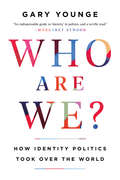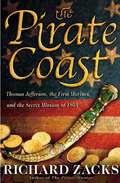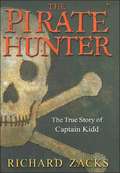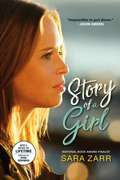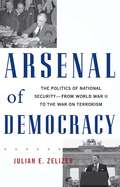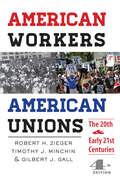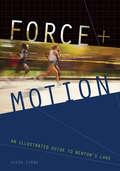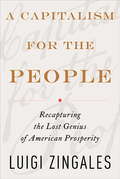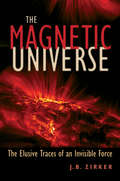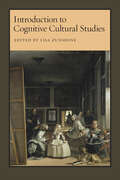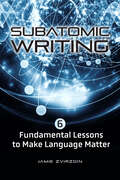- Table View
- List View
Who Are We -- And Should It Matter in the 21st Century?: How Identity Politics Took Over The World
by Gary YoungeFrom those who insist that Barack Obama is Muslim to the European legislators who go to extraordinary lengths to ban items of clothing worn by a tiny percentage of their populations, Gary Younge shows, in this fascinating, witty, and provocative examination of the enduring legacy and obsession with identity in politics and everyday life, that how we define ourselves informs every aspect of our social, political, and personal lives. Younge -- a black British male of Caribbean descent living in Brooklyn, New York, who speaks fluent Russian and French -- travels the planet in search of answers to why identity is so combustible. From Tiger Woods's legacy to the scandal over Danish cartoons of the Prophet Mohammed, he finds that identity is inescapable, but solidarity may not be as elusive as we fear. We are more alike than we are unalike. But the way we are unalike matters. To be male in Saudi Arabia, Jewish in Israel or white in Europe confers certain powers and privileges that those with other identities do not have. In other words, identity can represent a material fact in itself.As Gary Younge demonstrates in this classic book, now featuring a new introduction,, how we define ourselves affects every part of our lives: from violence on the streets to international terrorism; from changes in our laws to whom we elect; from our personal safety to military occupations. Moving between fascinating memoir and searing analysis, from beauty contests in Ireland to the personal views of Tiger Woods, from the author's own terrifying student days in Paris to how race and gender affect one's voting choices, Gary Younge makes surprising and enlightening connections and a devastating critique of the way our society really works.
The Pirate Coast: Thomas Jefferson, the First Marines, and the Secret Mission of 1805
by Richard ZacksA real-life thriller--the true story of the unheralded American who brought the Barbary Pirates to their knees. In an attempt to stop the legendary Barbary Pirates of North Africa from hijacking American ships, William Eaton set out on a secret mission to overthrow the government of Tripoli. The operation was sanctioned by President Thomas Jefferson, who at the last moment grew wary of "intermeddling" in a foreign government and sent Eaton off without proper national support. Short on supplies, given very little money and only a few men, Eaton and his mission seemed doomed from the start. He triumphed against all odds, recruited a band of European mercenaries in Alexandria, and led them on a march across the Libyan Desert. Once in Tripoli, the ragtag army defeated the local troops and successfully captured Derne, laying the groundwork for the demise of the Barbary Pirates. Now, Richard Zacks brings this important story of America's first overseas covert op to life.
The Pirate Coast: Thomas Jefferson, the First Marines, and the Secret Mission of 1805
by Richard ZacksA real-life thriller -- the true story of the unheralded American who brought the Barbary Pirates to their knees. In an attempt to stop the legendary Barbary Pirates of North Africa from hijacking American ships, William Eaton set out on a secret mission to overthrow the government of Tripoli. The operation was sanctioned by President Thomas Jefferson, who at the last moment grew wary of "intermeddling" in a foreign government and sent Eaton off without proper national support. Short on supplies, given very little money and only a few men, Eaton and his mission seemed doomed from the start. He triumphed against all odds, recruited a band of European mercenaries in Alexandria, and led them on a march across the Libyan Desert. Once in Tripoli, the ragtag army defeated the local troops and successfully captured Derne, laying the groundwork for the demise of the Barbary Pirates. Now, Richard Zacks brings this important story of America's first overseas covert op to life.
The Pirate Hunter: The True Story of Captain Kidd
by Richard ZacksEverybody knows the legend of Captain Kidd, America's most ruthless buccanneer. Few people realize that the facts of his life make for a much better tale. Kidd was actually a tough New York sea captain hired to chase pirates, a married war hero whose secret mission took a spectacularly bad turn. This harrowing tale traces Kidd's voyages in the 1690s from his home near Wall Street to Whitehall Palace in London, from the ports of the Caribbean to a secret pirate paradise off Madagascar. Author Richard Zacks, during his research, also unearthed the story of a long forgotten rogue named Robert Culliford, who dogged Kidd and led Kidd's crew to mutiny not once but twice. The lives of Kidd and Culliford play out like an unscripted duel: one man would hang in the harbor, the other would walk away with the treasure. Filled with superb writing and impeccable research, The Pirate Hunter is both a masterpiece of historical detective work and a ripping good yarn, and it delivers something rare: an authentic pirate story for grown-ups.
Story of a Girl (Little Brown Novels)
by Sara ZarrNow a movie on Lifetime! I was thirteen when my dad caught me with Tommy Webber in the back of Tommy's Buick, parked next to the old Chart House down in Montara at eleven o'clock on a Tuesday night. Tommy was seventeen and the supposed friend of my brother, Darren.I didn't love him.I'm not sure I even liked him.In a moment, Deanna Lambert's teenage life is changed forever. Struggling to overcome the lasting repercussions and the stifling role of "school slut," Deanna longs to escape a life defined by her past. With subtle grace, complicated wisdom, and striking emotion, Story of a Girl reminds us of our human capacity for resilience, epiphany, and redemption.
Sweethearts (Little Brown Novels)
by Sara ZarrAs children, Jennifer Harris and Cameron Quick were both social outcasts. They were also one another's only friend. So when Cameron disappears without warning, Jennifer thinks she's lost the only person who will ever understand her. Now in high school, Jennifer has been transformed. Known as Jenna, she's popular, happy, and dating, everything "Jennifer" couldn't be -- but she still can't shake the memory of her long-lost friend. When Cameron suddenly reappears, they are both confronted with memories of their shared past and the drastically different paths their lives have taken.From National Book Award finalist Sara Zarr, Sweethearts is a story about the power of memory, the bond of friendship, and the quiet resilience of our childhood hearts.
Arsenal of Democracy: The Politics of National Security--From World War II to the War on Terrorism
by Julian E. ZelizerIt has long been a truism that prior to George W. Bush, politics stopped at the water&’s edge—that is, that partisanship had no place in national security. In Arsenal of Democracy, historian Julian E. Zelizer shows this to be demonstrably false: partisan fighting has always shaped American foreign policy and the issue of national security has always been part of our domestic conflicts. Based on original archival findings, Arsenal of Democracy offers new insights into nearly every major national security issue since the beginning of the cold war: from FDR&’s masterful management of World War II to the partisanship that scarred John F. Kennedy during the Cuban Missile Crisis, from Ronald Reagan&’s fight against Communism to George W. Bush&’s controversial War on Terror. A definitive account of the complex interaction between domestic politics and foreign affairs over the last six decades, Arsenal of Democracy is essential reading for anyone interested in the politics of national security.
American Workers, American Unions: The Twentieth and Early Twenty-First Centuries (The American Moment)
by Robert H. Zieger Timothy J. Minchin Gilbert J. GallHighly acclaimed and widely read since its first publication in 1986, American Workers, American Unions provides a concise and compelling history of American workers and their unions in the twentieth century and the first decade of the twenty-first. Taking into account recent important work on the 1970s and the Reagan revolution, the fourth edition newly considers the stagflation issue, the rise of globalization and big box retailing, the failure of Congress to pass legislation supporting the right of public employees to collective bargaining, the defeat in Congress of legislation to revise the National Labor Relations Act, the emasculation of the Humphrey-Hawkins Act, and the changing dynamics of blue-collar politics. In addition to important new information on the 1970s and 1980s, the fourth edition contains a completely new final chapter. Largely written by Timothy J. Minchin, this chapter provides a rare survey of American workers and their unions between 9/11 and the 2012 presidential election. Gilbert J. Gall presents new information on government workers and their recent battles to defend workplace rights.
American Workers, American Unions: The Twentieth and Early Twenty-First Centuries (The American Moment)
by Robert H. Zieger Timothy J. Minchin Gilbert J. GallHighly acclaimed and widely read since its first publication in 1986, American Workers, American Unions provides a concise and compelling history of American workers and their unions in the twentieth century and the first decade of the twenty-first. Taking into account recent important work on the 1970s and the Reagan revolution, the fourth edition newly considers the stagflation issue, the rise of globalization and big box retailing, the failure of Congress to pass legislation supporting the right of public employees to collective bargaining, the defeat in Congress of legislation to revise the National Labor Relations Act, the emasculation of the Humphrey-Hawkins Act, and the changing dynamics of blue-collar politics. In addition to important new information on the 1970s and 1980s, the fourth edition contains a completely new final chapter. Largely written by Timothy J. Minchin, this chapter provides a rare survey of American workers and their unions between 9/11 and the 2012 presidential election. Gilbert J. Gall presents new information on government workers and their recent battles to defend workplace rights.
Force and Motion: An Illustrated Guide to Newton's Laws
by Jason ZimbaIsaac Newton developed three laws of motion that govern the everyday world. These laws are usually presented in purely mathematical forms, but Jason Zimba breaks with tradition and treats them visually. This unique approach allows students to appreciate the conceptual underpinnings of each law before moving on to qualitative descriptions of motion and, finally, to the equations and their solutions.Zimba has organized the book into seventeen brief and well-sequenced lessons, which focus on simple, manageable topics and delve into areas that often cause students to stumble. Each lesson is followed by a set of original problems that have been student-tested and refined over twenty years. Zimba illustrates the laws with more than 350 diagrams, an innovative presentation that offers a fresh way to teach the fundamentals in introductory physics, mechanics, and kinematics courses.
A Capitalism for the People: Recapturing the Lost Genius of American Prosperity
by Luigi ZingalesBorn in Italy, University of Chicago economist Luigi Zingales witnessed firsthand the consequences of high inflation and unemployment-paired with rampant nepotism and cronyism-on a country's economy. This experience profoundly shaped his professional interests, and in 1988 he arrived in the United States, armed with a political passion and the belief that economists should not merely interpret the world, but should change it for the better.In A Capitalism for the People, Zingales makes a forceful, philosophical, and at times personal argument that the roots of American capitalism are dying, and that the result is a drift toward the more corrupt systems found throughout Europe and much of the rest of the world. American capitalism, according to Zingales, grew in a unique incubator that provided it with a distinct flavor of competitiveness, a meritocratic nature that fostered trust in markets and a faith in mobility. Lately, however, that trust has been eroded by a betrayal of our pro-business elites, whose lobbying has come to dictate the market rather than be subject to it, and this betrayal has taken place with the complicity of our intellectual class.Because of this trend, much of the country is questioning-often with great anger-whether the system that has for so long buoyed their hopes has now betrayed them once and for all. What we are left with is either anti-market pitchfork populism or pro-business technocratic insularity. Neither of these options presents a way to preserve what the author calls "the lighthouse” of American capitalism. Zingales argues that the way forward is pro-market populism, a fostering of truly free and open competition for the good of the people-not for the good of big business.Drawing on the historical record of American populism at the turn of the twentieth century, Zingales illustrates how our current circumstances aren't all that different. People in the middle and at the bottom are getting squeezed, while people at the top are only growing richer. The solutions now, as then, are reforms to economic policy that level the playing field. Reforms that may be anti-business (specifically anti-big business), but are squarely pro-market. The question is whether we can once again muster the courage to confront the powers that be.
A Capitalism for the People: Recapturing the Lost Genius of American Prosperity
by Luigi ZingalesBorn in Italy, University of Chicago economist Luigi Zingales witnessed firsthand the consequences of high inflation and unemployment -- paired with rampant nepotism and cronyism -- on a country's economy. This experience profoundly shaped his professional interests, and in 1988 he arrived in the United States, armed with a political passion and the belief that economists should not merely interpret the world, but should change it for the better. In A Capitalism for the People, Zingales makes a forceful, philosophical, and at times personal argument that the roots of American capitalism are dying, and that the result is a drift toward the more corrupt systems found throughout Europe and much of the rest of the world. American capitalism, according to Zingales, grew in a unique incubator that provided it with a distinct flavor of competitiveness, a meritocratic nature that fostered trust in markets and a faith in mobility. Lately, however, that trust has been eroded by a betrayal of our pro-business elites, whose lobbying has come to dictate the market rather than be subject to it, and this betrayal has taken place with the complicity of our intellectual class. Because of this trend, much of the country is questioning -- often with great anger -- whether the system that has for so long buoyed their hopes has now betrayed them once and for all. What we are left with is either anti-market pitchfork populism or pro-business technocratic insularity. Neither of these options presents a way to preserve what the author calls "the lighthouse" of American capitalism. Zingales argues that the way forward is pro-market populism, a fostering of truly free and open competition for the good of the people -- not for the good of big business. Drawing on the historical record of American populism at the turn of the twentieth century, Zingales illustrates how our current circumstances aren't all that different. People in the middle and at the bottom are getting squeezed, while people at the top are only growing richer. The solutions now, as then, are reforms to economic policy that level the playing field. Reforms that may be anti-business (specifically anti-big business), but are squarely pro-market. The question is whether we can once again muster the courage to confront the powers that be.
The Magnetic Universe: The Elusive Traces of an Invisible Force
by J. B. ZirkerMagnetic fields permeate our vast universe, urging electrically charged particles on their courses, powering solar and stellar flares, and focusing the intense activity of pulsars and neutron stars.Magnetic fields are found in every corner of the cosmos. For decades, astrophysicists have identified them by their effects on visible light, radio waves, and x-rays. J. B. Zirker summarizes our deep knowledge of magnetism, pointing to what is yet unknown about its astrophysical applications. In clear, nonmathematical prose, Zirker follows the trail of magnetic exploration from the auroral belts of Earth to the farthest reaches of space. He guides readers on a fascinating journey of discovery to understand how magnetic forces are created and how they shape the universe. He provides the historical background needed to appreciate exciting new research by introducing readers to the great scientists who have studied magnetic fields. Students and amateur astronomers alike will appreciate the readable prose and comprehensive coverage of The Magnetic Universe.
Introduction to Cognitive Cultural Studies
by Lisa ZunshineDrawing on the explosion of academic and public interest in cognitive science in the past two decades, this volume features articles that combine literary and cultural analysis with insights from neuroscience, cognitive evolutionary psychology and anthropology, and cognitive linguistics. Lisa Zunshine’s introduction provides a broad overview of the field. The essays that follow are organized into four parts that explore developments in literary universals, cognitive historicism, cognitive narratology, and cognitive approaches in dialogue with other theoretical approaches, such as postcolonial studies, ecocriticism, aesthetics, and poststructuralism. Introduction to Cognitive Cultural Studies provides readers with grounding in several major areas of cognitive science, applies insights from cognitive science to cultural representations, and recognizes the cognitive approach’s commitment to seeking common ground with existing literary-theoretical paradigms. This book is ideal for graduate courses and seminars devoted to cognitive approaches to cultural studies and literary criticism.Contributors: Mary Thomas Crane, Nancy Easterlin, David Herman, Patrick Colm Hogan, Bruce McConachie, Alan Palmer, Alan Richardson, Ellen Spolsky, G. Gabrielle Starr, Blakey Vermeule, Lisa Zunshine
Subatomic Writing: Six Fundamental Lessons to Make Language Matter
by Jamie ZvirzdinSee science writing fundamentals afresh through a subatomic lens!In Subatomic Writing, Johns Hopkins University instructor Jamie Zvirzdin goes bravely into uncharted territory by offering a totally new kind of guide for writing about science—from the subatomic level up! Subatomic Writing teaches readers that the building blocks of language are like particles in physics. These particles, combined and arranged, form something greater than their parts: all matter in the literary universe. The six levels of language covered in this guide create writing that illuminates and energizes the reader to feel, learn, change, and act. This interdisciplinary approach helps scientists, science writers, and editors improve their writing in fundamental areas as they build from the sounds in a word to the pacing of a paragraph. These areas include• Sound and sense• Word classes• Grammar and syntax• Punctuation• Rhythm and emphasis• Pacing and coherenceEqually helpful for students who need to learn how to write clearly about science and scientists who need to hone their writing skills to create more effective course material, papers, and grant applications, this guide builds confidence in writing abilities as old skills are taught in new, exciting ways. Each lesson provides exercises that build on each other, strengthening readers' capacity to communicate ideas and data, all while learning basic particle physics along the way.
Subatomic Writing: Six Fundamental Lessons to Make Language Matter
by Jamie ZvirzdinSee science writing fundamentals afresh through a subatomic lens!In Subatomic Writing, Johns Hopkins University instructor Jamie Zvirzdin goes bravely into uncharted territory by offering a totally new kind of guide for writing about science—from the subatomic level up! Subatomic Writing teaches readers that the building blocks of language are like particles in physics. These particles, combined and arranged, form something greater than their parts: all matter in the literary universe. The six levels of language covered in this guide create writing that illuminates and energizes the reader to feel, learn, change, and act. This interdisciplinary approach helps scientists, science writers, and editors improve their writing in fundamental areas as they build from the sounds in a word to the pacing of a paragraph. These areas include• Sound and sense• Word classes• Grammar and syntax• Punctuation• Rhythm and emphasis• Pacing and coherenceEqually helpful for students who need to learn how to write clearly about science and scientists who need to hone their writing skills to create more effective course material, papers, and grant applications, this guide builds confidence in writing abilities as old skills are taught in new, exciting ways. Each lesson provides exercises that build on each other, strengthening readers' capacity to communicate ideas and data, all while learning basic particle physics along the way.
